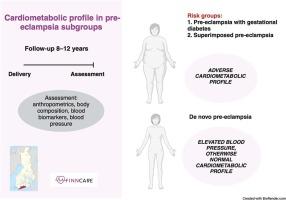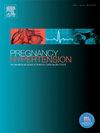Cardiometabolic health 8–12 years after pre-eclampsia: Role of obesity and gestational diabetes (FINNCARE study)
IF 2.9
4区 医学
Q2 OBSTETRICS & GYNECOLOGY
Pregnancy Hypertension-An International Journal of Womens Cardiovascular Health
Pub Date : 2025-06-09
DOI:10.1016/j.preghy.2025.101226
引用次数: 0
Abstract
Objective
This study examined the long-term cardiometabolic health in subgroups of pre-eclampsia (PE) to identify individuals who would benefit from targeted cardiovascular screening.
Design and main outcome: A cross-sectional cohort. We compared cardiometabolic profile (anthropometrics, body composition, blood biomarkers, and blood pressure) among normotensive control pregnancies (n = 92), de novo PE (n = 156), de novo PE with gestational diabetes mellitus (GDM) (PE + GDM, n = 16), and PE superimposed on chronic hypertension (n = 18). With sensitivity analysis, we compared early-onset PE (EOPE n = 27) and late-onset PE (LOPE n = 165) groups.
Results
Cardiometabolic profiles were similar between de novo PE and normotensive groups, except for higher blood pressure in the de novo PE group. Women with PE + GDM and superimposed PE had higher median BMI (30.8 kg/m2, IQR 7.6 and 30.6 kg/m2, IQR 9.6, respectively) and more adiposity than de novo PE and normotensive groups. In the multivariable models, BMI was associated with low-and high-density lipoprotein cholesterol (β = 0.19, 95 % CI: 0.008 to 0.05; β = -0.41, 95 % CI: −0.03 to −0.02, respectively), high-sensitivity C-reactive protein (β = 0.64, 95 % CI: 0.11–0.15), triglyceride (β = 0.52, 95 % CI: 0.03 to 0.05) as well as glucose and insulin concentrations in the whole study population. Women with EOPE had higher low-density lipoprotein and total cholesterol concentrations than women in LOPE and control groups.
Conclusions
Women with PE + GDM and with superimposed PE exhibited an adverse cardiometabolic profile characterized by high BMI. This highlights the need for targeted cardiovascular prevention. Women with de novo PE should undergo regular blood pressure monitoring.

子痫前期后8-12年的心脏代谢健康:肥胖和妊娠糖尿病的作用(FINNCARE研究)
目的研究子痫前期(PE)亚组的长期心脏代谢健康状况,以确定有针对性心血管筛查的受益人群。设计和主要结果:横断面队列。我们比较了正常控制妊娠(n = 92)、新生PE (n = 156)、新生PE合并妊娠糖尿病(GDM) (PE + GDM, n = 16)和PE合并慢性高血压(n = 18)的心脏代谢特征(人体测量学、身体组成、血液生物标志物和血压)。通过敏感性分析,我们比较了早发性PE (EOPE n = 27)和晚发性PE (LOPE n = 165)两组。结果除新生PE组血压升高外,新生PE组与正常血压组心肌代谢谱相似。PE + GDM和合并PE的女性BMI中位数较高(分别为30.8 kg/m2, IQR 7.6和30.6 kg/m2, IQR 9.6),肥胖程度高于新生PE组和正常PE组。在多变量模型中,BMI与低、高密度脂蛋白胆固醇相关(β = 0.19, 95% CI: 0.008 ~ 0.05;β = -0.41, 95% CI: - 0.03至- 0.02),高敏c反应蛋白(β = 0.64, 95% CI: 0.11-0.15),甘油三酯(β = 0.52, 95% CI: 0.03至0.05)以及整个研究人群的葡萄糖和胰岛素浓度。EOPE患者的低密度脂蛋白和总胆固醇浓度高于LOPE组和对照组。结论PE + GDM和合并PE的女性表现出以高BMI为特征的不良心脏代谢特征。这突出了有针对性地预防心血管疾病的必要性。新发PE的女性应定期进行血压监测。
本文章由计算机程序翻译,如有差异,请以英文原文为准。
求助全文
约1分钟内获得全文
求助全文
来源期刊

Pregnancy Hypertension-An International Journal of Womens Cardiovascular Health
OBSTETRICS & GYNECOLOGYPERIPHERAL VASCULAR-PERIPHERAL VASCULAR DISEASE
CiteScore
4.90
自引率
0.00%
发文量
127
期刊介绍:
Pregnancy Hypertension: An International Journal of Women''s Cardiovascular Health aims to stimulate research in the field of hypertension in pregnancy, disseminate the useful results of such research, and advance education in the field.
We publish articles pertaining to human and animal blood pressure during gestation, hypertension during gestation including physiology of circulatory control, pathophysiology, methodology, therapy or any other material relevant to the relationship between elevated blood pressure and pregnancy. The subtitle reflects the wider aspects of studying hypertension in pregnancy thus we also publish articles on in utero programming, nutrition, long term effects of hypertension in pregnancy on cardiovascular health and other research that helps our understanding of the etiology or consequences of hypertension in pregnancy. Case reports are not published unless of exceptional/outstanding importance to the field.
 求助内容:
求助内容: 应助结果提醒方式:
应助结果提醒方式:


